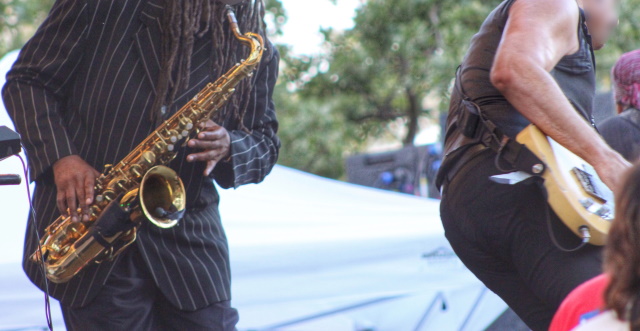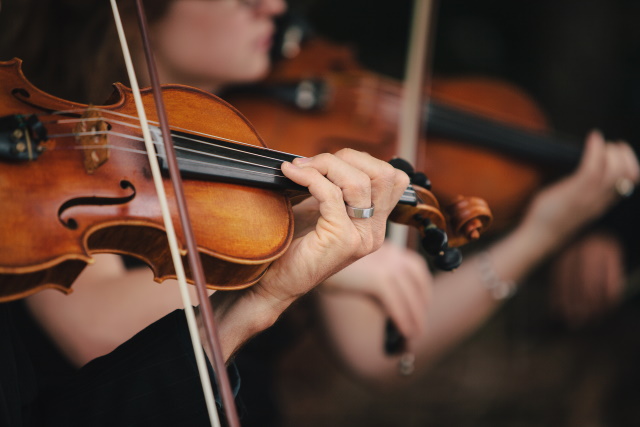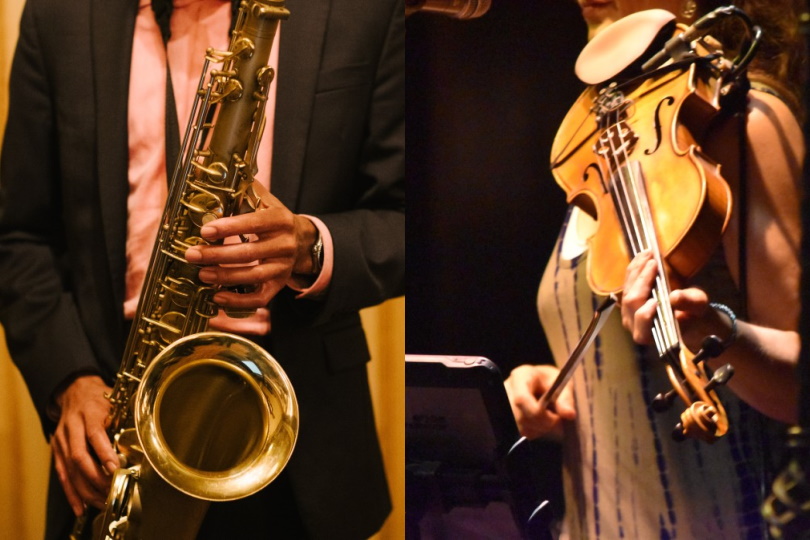If you’re interested in playing an instrument, and you both like the sound of string instruments and that of the saxophone played in jazz groups, you may be torn between taking up the saxophone or the violin.
The violin has a steeper learning curve compared to the sax but is a very versatile instrument for which lots of written music exists. The saxophone is easier to pick up but is less practical, louder and bulkier. However, it’s a great instrument for playing jazz and pop and for improvisation.
If you’re in a hurry, the following recap should help you decide which of the violin or the saxophone is the best instrument for you to play:
| Aspect | Violin | Saxophone |
| Learning curve | Slow learning curve | Faster learning curve |
| Repertoire & versatility | Very large repertoire with music for many ensemble options. Adaptable to play a variety of genres. | Not so much written music, but improvisation plays a big role. Widely used in jazz, pop and band music. |
| Practicality | Easily transportable. Can be practiced with a low level of sound in an apartment. | Larger, heavier, harder to carry. Very loud sound, requires a practice room. |
| Instrument & maintenance cost | High-end violins are expensive, but cheap beginner instruments are available. Maintenance costs are higher. | High-end saxophones are cheaper than violins, but cheap saxophones to start with are pricier. More affordable maintenance cost. |
| Skills transferability | Easy skill transfer between string instruments. | Easy skill transfer between different sax types, but fingering differ from other woodwind instruments. |
| Personal preference | Ideal if you prefer orchestral music and the violin’s mellow sound. | Ideal if you prefer jazz music and the excited sound of the saxophone. |

Table of Contents
Saxophone vs violin learning curve
The saxophone has a shorter learning curve than the violin.The saxophone player has less to learn than the violist before producing a decent sound.
The saxophone, as a woodwind instrument, is using a single-reed mouthpiece. The most difficult part for a new player is to learn and practice breathing and blowing techniques, called embouchure.
The correct blowing technique is essential to provide enough air into the instrument’s tube.
As soon as the basic blowing technique is learned, the player can start producing different notes. To produce a note, the saxophone player covers and uncovers holes in the instrument’s tube by pressing keys in specific combinations.
A beginner sax player can play a simple melody within days, and simple songs played fairly quickly.
Violin
A part of the string family, the violin has inherent characteristics which give it a steeper learning curve.
It is fretless with no marks to indicate where to place your finger on the string to produce a specific note. Your ears have to be trained to determine whether a note is on pitch.
New violinists often find it hard to master the bow technique with one hand, while the other hand is trying to find the right harmonic places on the strings. Getting used to two hands doing completely different types of movement at once can take months.
It usually takes quite a while before a new learner can produce one or two decent notes on the violin.

Repertoire & versatility
Violin
The violin has a huge repertoire of classical music. Since the first violins were made in the 1500s, music has been written for it. Literary thousands of pieces of violin music have been written over the centuries.
Violins form the basis of classical orchestras, chamber music groups and small ensembles.
Except for music specifically composed for wind instruments, brass ensembles and solo instruments, violin scores are virtually included in all other works.
The violin is a versatile instrument. Besides classical music, violins are also part of Celtic folk music and pop music. They are widely used in combination with other strings, woodwind and brass instruments. They blend easily with most other instrument’s sounds.
Violinists are always in demand to play in ensembles, orchestras and even bands. Depending on your level and the genres you like, as a violinist you’ll almost always find other musicians to make music with.
Saxophone
As the saxophone is a newer instrument (1840s), there are fewer composed music scores for it than for the violin.
Saxophone players, however, especially in jazz groups, often don’t need written music. The saxophone is great for improvising.
Coleman Hawkins played beautiful saxophones jazz solos as early as 1939. In the 1980s the saxophonist John Klemmers showed that the saxophone is ideal for smooth jazz with his album “Touch”.
The sax has always been used in a variety of roles. It’s often the melody player in jazz combos, military bands and big bands. Other common roles include playing rock and roll, pop, and smooth jazz.
Although rarely, saxophones are sometimes used in classical orchestras, e.g. Jacques Ibert’s “Concertino da Camera for alto saxophone and 11 instruments”.
As a saxophone player, you’ll have the flexibility of joining groups in any genre. After attaining higher levels, you will also be able to play lead parts in ensembles.
Sax vs violin: practicality
The saxophone is larger and heavier to carry than the violin. The violin case is easy to take with you in a car or public transport.
On the other hand, the saxophone is more rugged. The violin’s wood is sensitive to temperature changes and it can relatively crack easily. The saxophone is made from metal and more durable.
The place where you will be practicing might also influence your choice of which instrument to play. If you live in an apartment, noise is likely a factor.
The saxophone is a very loud instrument. It’s hard to practice the sax without using the full dynamic range. Ideally, you need a place that’s phonically isolated.
With the violin, it’s easier to practice at lower volumes, although the upper range can also be loud. Neighbors are generally more tolerant towards violinists than sax players.
Saxophone vs violin: purchase & maintenance cost
High-end saxophones are more affordable than top violins. On the other hand, you can generally buy a cheap violin that sounds alright for under $100, while an Alto Saxophone will run at least $400.
| Violin (Standard) | Saxophone (Standard) | |
| Instrument | $280 – $6,000 | $800 – $3,000 |
| Bow | $50 – $200 | N/A |
| Mouthpiece | N/A | $30 – $100 |
Maintenance costs are generally higher for the violin than the sax:
| Part or service | Violin (Standard) | Saxophone (Standard) |
| Set of strings | $30 – $60 | N/A |
| Pegs | $35 – $45 | N/A |
| Fit bridge | $65 – $95 | N/A |
| Resurface fingerboard | $50 – $75 | N/A |
| Install nut and saddle | $50 -$70 | N/A |
| Solder key | N/A | $25 – $35 per key |
| Replace key springs | N/A | $10 – $20 per pair |
| Touch-hole repair | N/A | $30 – $35 per hole |
Choosing the sax or the violin: skills transferability
Saxophones essentially all have the same fingering. If you’ve learned to play a B-flat saxophone, the fingering can be carried over to the E-flat saxophone. However, the fingering is different from other woodwind instruments.
The violin’s fretting and bowing skills are more easily transferable to other fretless string instruments like the viola or cello.
Final words: personal preferences
Ultimately, whether you choose the saxophone or the violin depends on your preference in terms of power source and sound.
Does powering your instrument with your mouth or with your arms and hands attract you the most? Do you prefer the violin’s delicate and sweet sound or the sax’s harder and more excitable sound?
Obviously, the musical genres you favor will also contribute to your choice, e.g. classical vs jazz. Cost, convenience, and portability are also factors to take into account.

